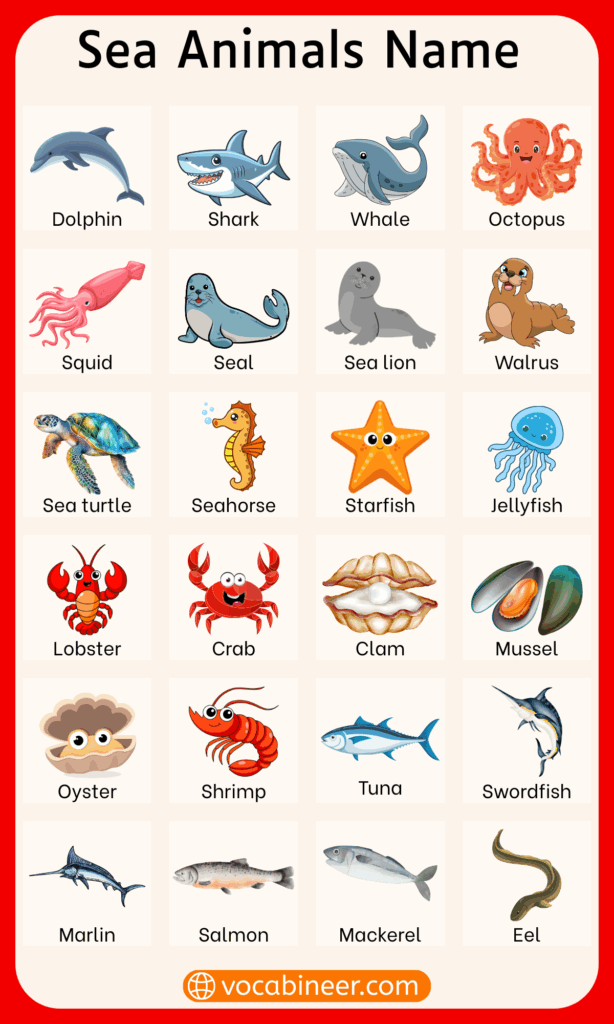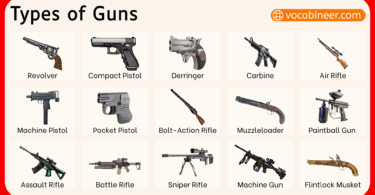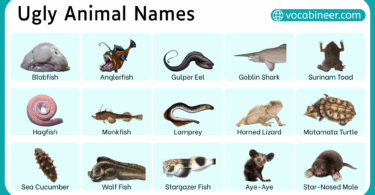The ocean is full of amazing creatures like fish, whales, dolphins, turtles, crabs, squids, and sharks. Some are tiny while others are the biggest animals on Earth, making the sea an exciting place of life and variety. By learning the names of sea animals with their images, you can talk more easily in school, travel, and everyday conversations about ocean life.
In This Page
List of Sea Animals with Names in English
The ocean is home to an incredible range of creatures, and this complete list of sea animals with names and pictures helps you learn them quickly.
Mammals Names:
- Whale
- Dolphin
- Porpoise
- Seal
- Sea Lion
- Walrus
- Manatee
- Dugong
- Sea Otter
- Polar Bear
Fish Names:
- Shark
- Tuna
- Salmon
- Swordfish
- Marlin
- Mackerel
- Herring
- Anchovy
- Eel
- Pufferfish
- Angelfish
- Clownfish
- Lionfish
- Seahorse
- Flying Fish
- Parrotfish
- Barracuda
Crustaceans Name:
- Crab
- Lobster
- Shrimp
- Prawn
- Krill
- Hermit Crab
Mollusks Names:
- Octopus
- Squid
- Cuttlefish
- Clam
- Oyster
- Mussel
- Scallop
- Nautilus
Cnidarians Names:
- Jellyfish
- Coral
- Sea Anemone
Echinoderms Names:
- Starfish
- Sea Urchin
- Sand Dollar
- Sea Cucumber
Reptiles Names:
- Sea Turtle
- Marine Iguana
- Sea Snake
- Saltwater Crocodile

Common Fish Found in the Ocean
Fish are the most common sea animals. They come in many sizes and colors and are a major source of food and balance in the ecosystem. Below are examples of well-known ocean fish.
- Tuna: Large and fast-swimming fish, often traveling in schools, valued for food worldwide.
- Salmon: Known for swimming from rivers to seas, often returning to their birthplace to lay eggs.
- Mackerel: Small, shiny fish with stripes, living in groups and eaten fresh or canned.
- Sardine: Tiny fish found in large schools, important for both people and bigger predators.
- Clownfish: Brightly colored fish, famous for living in sea anemones for safety.
- Swordfish: Powerful fish with a long, flat bill, able to swim quickly in open waters.
Names of Marine Mammals
Marine mammals breathe air, give birth to live young, and depend on the ocean for food. They are among the most intelligent and social sea animals.
- Dolphin: Smart, playful mammals known for swimming in groups and using sounds to communicate.
- Whale: The largest animals on Earth, feeding on small fish or krill depending on the species.
- Seal: Semi-aquatic mammals with flippers, often seen resting on ice or beaches.
- Sea Lion: Similar to seals but with visible ears and stronger ability to walk on land.
- Walrus: Big animals with long tusks, living in cold seas and feeding mostly on clams.
Types of Crustaceans in the Sea
Crustaceans are animals with hard shells and jointed legs. They live on the seafloor and play an important role in marine food chains.
- Crab: Animals with broad shells and claws, moving sideways on sandy or rocky shores.
- Lobster: Large crustaceans with strong claws, usually found in rocky seabeds.
- Shrimp: Small creatures with long bodies and legs, commonly eaten worldwide.
- Prawn: Similar to shrimp but often larger, used in cooking and seafood dishes.
- Krill: Very small crustaceans, forming huge swarms and serving as food for whales.
List of Mollusks in the Ocean
Mollusks are soft-bodied animals, many with shells for protection. They include some of the most intelligent sea creatures.
- Octopus: Intelligent mollusk with eight arms, able to change color and escape predators.
- Squid: Fast swimmers with tentacles and ink release for defense.
- Cuttlefish: Relatives of squids, known for changing colors to blend with surroundings.
- Oyster: Shellfish often farmed for food and pearls.
- Mussel: Small shellfish that attach to rocks or structures underwater.
- Clam: Bivalves with shells that bury themselves in sand.
- Sea Snail: Mollusks with spiral shells, crawling slowly across reefs or seagrass.
Names of Echinoderms
Echinoderms are spiny-skinned animals that usually live on the sea floor. They play a role in cleaning the ocean environment.
- Starfish: Animals with five arms, able to regrow lost limbs.
- Sea Urchin: Round creatures covered with spines, living on rocky seabeds.
- Sea Cucumber: Soft-bodied echinoderms that recycle nutrients in ocean floors.
- Brittle Star: Star-like echinoderms with long, flexible arms.
Ocean Reptiles Names
Some reptiles spend much of their life in the ocean. They breathe air but depend on seawater habitats for survival.
- Sea Turtle: Ancient reptiles that lay eggs on beaches but spend most of their life in the ocean.
- Sea Snake: Venomous reptiles adapted to saltwater, found mostly in warm seas.
- Marine Iguana: Unique to the Galápagos Islands, feeding on algae from rocks.
Types of Sharks in the Ocean
Sharks are powerful fish with skeletons made of cartilage. They play an important role as top predators in marine ecosystems.
- Great White Shark: Large shark known for sharp teeth and strong hunting skills.
- Hammerhead Shark: Recognized by its wide, hammer-shaped head that improves vision.
- Tiger Shark: Strong predators with stripes, eating many kinds of sea animals.
- Whale Shark: The biggest fish in the sea, gentle and feeding on plankton.
List of Rays and Skates
Rays and skates are flat-bodied fish related to sharks. They glide across the seabed or open waters.
- Stingray: Flat fish with a long tail carrying a venomous stinger for defense.
- Manta Ray: Huge rays with wide fins, known for graceful swimming.
- Electric Ray: Capable of producing electric shocks to defend itself or stun prey.
Names of Small Sea Creatures
Many small creatures also live in the sea, forming an important part of marine ecosystems.
- Jellyfish: Soft-bodied creatures with tentacles, drifting with ocean currents.
- Seahorse: Small fish shaped like horses, where males carry the babies.
- Coral: Marine animals forming reefs, providing homes for countless species.
- Plankton: Tiny organisms floating in water, feeding larger animals.
Rare and Unique Sea Animals
Some sea animals are unusual or rare, living in specific habitats or deep waters.
- Narwhal: Whale with a long tusk, often called the unicorn of the sea.
- Dugong: Marine mammal related to manatees, feeding on seagrass.
- Beluga Whale: White-colored whales known for their social nature and vocal sounds.
- Giant Squid: Deep-sea squid with very long arms, rarely seen by humans.
Conclusion
Learning the names of sea animals with their images helps us connect words to the creatures that live in oceans. From tiny plankton to giant whales, each name reflects how these animals fit into marine life. This post brings together the names of fish, mammals, reptiles, and other groups, so readers can talk about them confidently in classrooms, nature discussions, and everyday conversations.
FAQs about
Some of the most common sea animals are tuna, sardines, dolphins, jellyfish, crabs, and sea turtles, as they live in many different regions.
Marine mammals include whales, dolphins, seals, sea lions, and walruses, all of which breathe air and feed their young with milk.
Certain species can be harmful, such as sharks, sea snakes, jellyfish, and stingrays, though most attacks or stings happen only when animals feel threatened.
Tiny organisms like plankton, krill, and coral polyps are vital because they support the entire food chain and keep ecosystems alive.
Rare creatures include the narwhal, giant squid, dugong, and beluga whale, as they live in specific habitats or deep waters.
Read More




